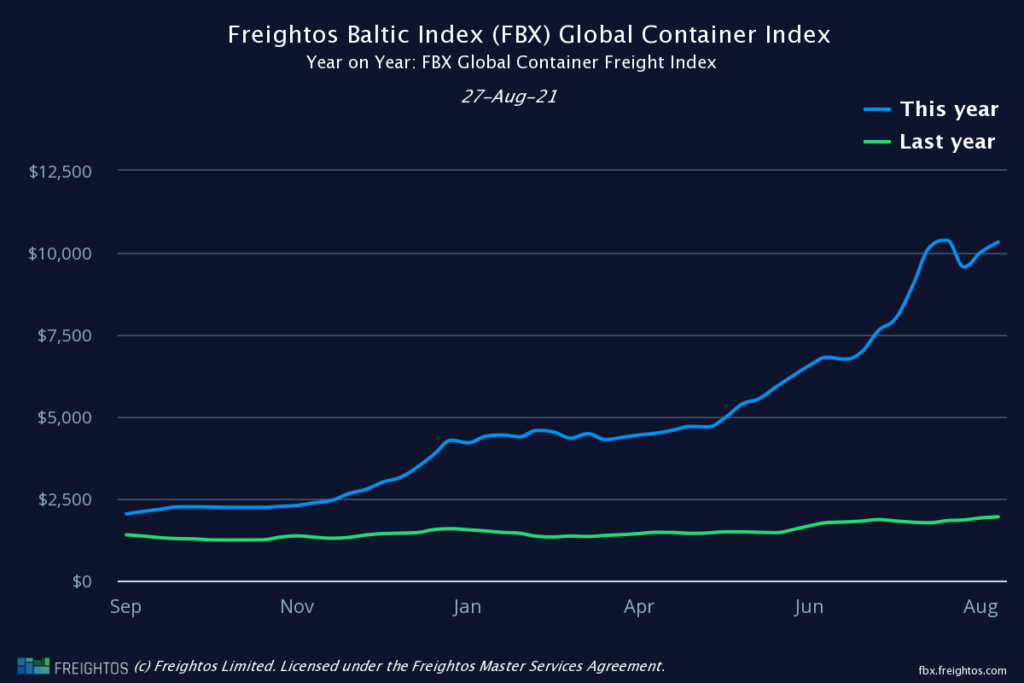Briefing:
- Global shipping issues are creating delays and pushing prices higher. This is a knock-on effect of the pandemic that will eventually return to normal.
- Augmented Reality innovation includes a new laser projector small enough to fit into a regular pair of glasses.
- Working from home…
Global Shipping Bottlenecks
As the Christmas shopping season approaches, you’ve probably seen warnings that September is the new December. In other words, you should plan well in advance if you have a large shopping list. This shouldn’t come as a surprise as global supply chains are still being affected by COVID and last year’s shutdown.
Several problems related to shipping have come up recently including: container shortages, rising energy costs, larger ships that take longer to unload, and surprise COVID infections that prevent port entry. We are experiencing issues with both supply and demand, which result in higher prices.
You can see the global shipping FBX chart here, or below. The Freightos Baltic Index that tracks the average cost of global shipping is 6.5x higher than pre-COVID. In a similar vein to our article on lumber, these price spikes reflect a complete shock to an extremely complex and sensitive system, and will eventually normalize.

Although many digital businesses rely on physical components in data centers to operate, they don’t always need to ship physical products to generate revenue. Software as a Service (SaaS) is less susceptible to physical disruptions because it is a digital service. When society unexpectedly grinds to a halt, which can and does occur, software and service businesses have an advantage over traditional businesses.
Back to Christmas shopping, we used to gift DVDs, CDs and video games, but we are moving towards a more digital world. With a $5 subscription to Spotify and a $9 subscription to Netflix, you can access near-unlimited content. You can’t really gift an album or a movie if someone already has access to it via a digital subscription. This should affect consumer behavior. Digital consumption is usually cheaper for the consumer, better for the investor, and overall has a dramatically lower impact on the environment. This is an example of deflation due to technology.
AR (Augmented Reality) is making real progress
You may have tried Oculus Go – the wireless Virtual Reality headset from Facebook. In VR, you have to wear bulky headsets that take up your full field of vision with a virtual world. It’s an amazing experience, but it’s not something you would want to wear regularly.
There will be AR (Augmented Reality) eventually, where you will see the world around you as well as overlays of graphics and other data. As of today, minimalist AR headsets are not available. Check out the most recent AR models made by Vuzix for context. This isn’t something someone would wear voluntarily.
Bharath Rajagopalan chairs the LaSAR alliance, an organization within IEEE that supports applications of laser scanning technology in Augmented Reality. Bharath says, “AR smart glasses should look, feel, and perform like real eyeglasses—with the additional benefits of augmented information, That means they should be able to be worn all day, have lenses that can automatically darken when exposed to sunlight, and weigh about the same as a pair of traditional eyeglasses: 70 grams or less.”
Bharath’s company, STMicroelectronics, recently produced a laser projector that uses just .7 cubic centimeters of space and only 1 watt of power. This is small enough to fit into a normal pair of glasses, which is also about .7 cubic centimeters at the joint. AR will not truly take off until the size is small enough to fit in a standard pair of glasses, and ST seems to have accomplished this goal. It won’t take long for AR glasses to become popular once the size issue is addressed. When AR is ready for consumers, VR software leaders like Facebook, and others, will be well-positioned to create entirely new businesses.
Return to remote work
Google recently announced they are moving their return to the office date back from October to January. You can bet that others will follow their example. In New York, train commuting activity to Grand Central and other major hubs is still just 35% of their pre-pandemic high and just 23% of office workers are back at their desks. San Francisco has the lowest office turnout in the country at 19%.
Many companies are considering a 2-day office workweek with the rest of the work done remotely. How do you coordinate and prioritize the 2 days that are in person? It’s not an easy question to answer. We still have a long way to go to return to the office.
Businesses will have to calculate whether the real estate savings and access to remote talent outweighs any lack in productivity or creativity. That comparison will be extremely difficult to calculate. While real estate costs require no interpretation, the impact of remote work on business results is subject to major hindsight bias. In other words, when business is suffering, it will almost certainly be blamed on remote work, and vice versa. With the new Mu variant appearing in the news recently, you can bet that remote work will stick around in full for another winter.
Weekly Articles by Osbon Capital Management:
"*" indicates required fields
